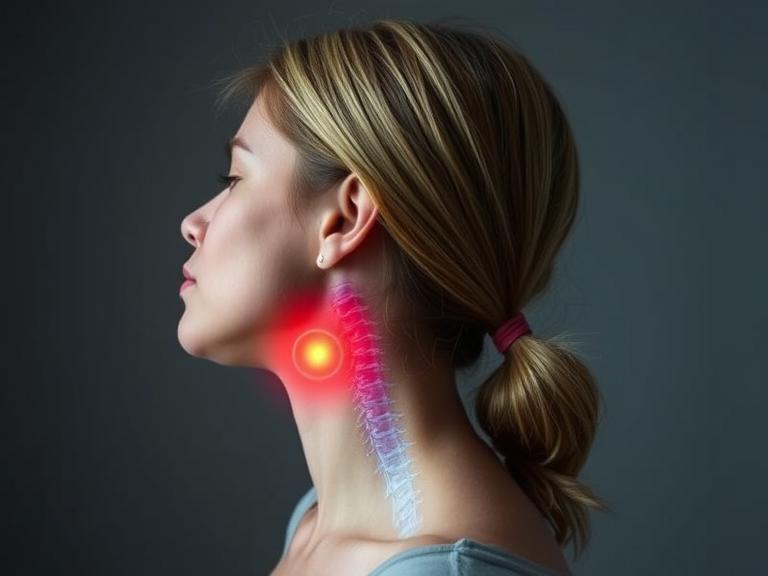In today’s fast-paced, screen-dominated world, neck pain has become one of the most common musculoskeletal complaints. Often ignored at the beginning, it gradually grows into a persistent problem affecting work, sleep, and quality of life. This condition, commonly referred to as cervical pain, stems from the cervical spine—the upper part of the spinal column that supports the head.
Understanding its underlying causes, identifying the symptoms early, and applying practical solutions are essential to recovery. In this blog, we will walk you through the causes of cervical pain explained in detail, the major symptoms you should never ignore, and effective cervical pain relief techniques. We’ll also emphasize how cervical pain and posture correction play a vital role in long-term management.

What is Cervical Pain?
Cervical pain refers to discomfort or stiffness in the neck region, usually caused by issues in the vertebrae, muscles, ligaments, or discs of the cervical spine. It may be acute, lasting a few days to weeks, or chronic, persisting for months and sometimes radiating into shoulders and arms.
The cervical spine is made of seven vertebrae (C1–C7), and because it supports the head and allows movement, it is highly vulnerable to stress and strain.
Causes of Cervical Pain Explained
When we look at the causes of cervical pain explained, we realize that both lifestyle and medical conditions can trigger it. Below are the most common factors:
1. Poor Posture
One of the leading causes of cervical pain explained is poor posture, often due to prolonged mobile or computer use. The “text neck” phenomenon, where the head is bent forward for long durations, places immense stress on the cervical spine.
2. Muscle Strain
Overuse of neck muscles during physical activity, lifting heavy objects improperly, or sudden jerks during travel often result in painful muscle strains.
3. Age-Related Wear and Tear
With age, discs in the cervical spine lose elasticity and cushioning. This degeneration leads to cervical spondylosis, one of the major causes of cervical pain explained in older adults.
4. Herniated Disc
A slipped or herniated disc in the cervical region can put pressure on nerves, causing pain, tingling, and numbness.
5. Injuries and Accidents
Whiplash injuries from road accidents or falls are sudden causes of cervical pain explained that need immediate medical attention.
6. Stress and Emotional Tension
Mental stress often causes tightening of neck and shoulder muscles, contributing to chronic cervical pain.
7. Sleeping Habits
Improper sleeping positions, poor-quality pillows, and unsupportive mattresses may worsen or directly trigger cervical pain.
Symptoms of Cervical Pain
Recognizing the symptoms early is key to proper management. Symptoms vary depending on the underlying cause but usually include:
- Stiffness and limited range of motion
- Sharp or dull aching pain in the neck
- Radiating pain to shoulders, arms, or hands
- Tingling or numbness in fingers
- Muscle spasms in the neck and upper back
- Headaches originating at the base of the skull
- Fatigue and disturbed sleep due to persistent discomfort
If these symptoms persist for more than a few weeks, it’s important to seek professional medical advice.
Cervical Pain Relief Techniques
When discomfort sets in, natural and non-invasive strategies often provide significant relief. Here are proven cervical pain relief techniques you can try:
1. Hot and Cold Therapy
- Cold packs reduce inflammation in acute injuries.
- Heat packs relax stiff muscles and improve circulation.
Alternating between hot and cold is one of the most effective cervical pain relief techniques.
2. Gentle Neck Exercises
Regular neck stretches prevent stiffness and strengthen muscles. Examples:
- Neck tilts (side-to-side and forward-backward)
- Shoulder rolls
- Chin tucks for posture correction
Daily practice of these movements is among the simplest cervical pain relief techniques.
3. Massage Therapy
Gentle massage using warm oils (mustard, coconut, or olive) improves flexibility, relaxes muscles, and eases tension.
4. Good Sleep Habits
Using orthopedic pillows and sleeping on your back or side prevents overnight strain, making sleep hygiene one of the practical cervical pain relief techniques.
5. Yoga and Stretching
Postures like Cat-Cow, Cobra, and Child’s Pose relieve stress from the cervical spine while strengthening supportive muscles.
6. Stress Management
Meditation, deep breathing, and mindfulness practices lower stress-induced muscular tension, another important cervical pain relief technique.
Cervical Pain and Posture Correction
One of the most important long-term solutions is cervical pain and posture correction. Poor posture is both a cause and a consequence of neck pain, and without fixing it, any temporary relief will not last.
Why Posture Matters
- Slouching or forward head posture increases pressure on the cervical spine.
- A 15-degree forward tilt of the head adds around 12 kg of extra force on the neck.
- Cervical pain and posture correction helps redistribute weight properly, reducing unnecessary stress.
Posture Correction Tips
- Adjust your workstation so the screen is at eye level.
- Keep shoulders relaxed and back supported.
- Avoid cradling the phone between your ear and shoulder.
- Take frequent breaks during long sitting sessions.
By practicing cervical pain and posture correction, you can prevent flare-ups and ensure long-term spinal health.
Lifestyle Adjustments for Cervical Health
Apart from cervical pain relief techniques and posture correction, small lifestyle changes significantly impact cervical health:
- Hydration: Keep spinal discs nourished with adequate water.
- Balanced diet: Add calcium, vitamin D, and magnesium for bone and muscle strength.
- Active lifestyle: Avoid sedentary routines; include walking or swimming.
- Limit mobile screen time: Reduce downward head tilt by holding devices at eye level.
Medical Solutions for Cervical Pain
When pain becomes chronic or severe, medical interventions may be required. These include:
- Physical therapy: Supervised exercises and traction techniques.
- Medications: Pain relievers, muscle relaxants, or anti-inflammatory drugs.
- Injections: Corticosteroid injections for severe nerve pain.
- Surgery: Rare cases such as herniated discs or spinal stenosis may need surgical correction.
Preventing Cervical Pain
Prevention is always better than cure. Combining cervical pain relief techniques with awareness of the causes of cervical pain explained ensures long-lasting health.
- Practice correct posture daily.
- Stretch every morning and during work breaks.
- Invest in ergonomic chairs and supportive pillows.
- Avoid carrying heavy bags on one shoulder.
- Stay mindful of stress and manage it proactively.
When to Seek Professional Help
While most cases respond well to cervical pain relief techniques, immediate medical consultation is necessary if you experience:
- Severe pain radiating to arms or legs
- Numbness or tingling in hands
- Loss of coordination or balance
- Headaches accompanied by vision problems
- Pain persisting beyond a few weeks despite home remedies
Final Thoughts
Understanding cervical pain is the first step toward recovery. With the causes of cervical pain explained, recognizing the symptoms, and using practical cervical pain relief techniques, you can take charge of your spinal health. Moreover, incorporating cervical pain and posture correction into your daily routine ensures not only relief but also prevention of recurring issues.
A combination of lifestyle changes, stress management, proper posture, and timely medical care can help you lead a pain-free and active life. Remember, your cervical spine supports one of the most vital parts of your body—the head. Treat it with care, and it will support you throughout your life.



